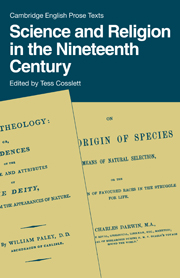Book contents
- Frontmatter
- Contents
- Editorial note
- Introductory essay
- 1 WILLIAM PALEY, Natural Theology (1802), Chapters 1–3
- 2 ROBERT CHAMBERS, Vestiges of the Natural History of Creation (1844), Chapter 14, ‘Hypothesis of the Development of the Vegetable and Animal Kingdoms’
- 3 HUGH MILLER, The Testimony of the Rocks (1857), Lecture Fifth, ‘Geology in its Bearings on the Two Theologies’, Part I
- 4 CHARLES DARWIN, On the Origin of Species (1859), Chapter 14, ‘Recapitulation and Conclusion’
- 5 CHARLES GOODWIN, ‘On the Mosaic Cosmogony’, Essays and Reviews (1860)
- 6 LEONARD HUXLEY, Life and Letters of Thomas Henry Huxley (1903), vol. 1, Chapter 14, ‘1859-1860’
- 7 CHARLES DARWIN, The Descent of Man (1871), Chapter 21, ‘General Summary and Conclusion’
- 8 JOHN TYNDALL, ‘The Belfast Address’, Nature, 20 August 1874
- 9 FREDERICK TEMPLE, The Relations between Religion and Science (1884), Lecture VI, ‘Apparent Collision between Religion and the Doctrine of Evolution’; and Lecture VIII, ‘The Conclusion of the Argument’
- Notes
- Select booklist
4 - CHARLES DARWIN, On the Origin of Species (1859), Chapter 14, ‘Recapitulation and Conclusion’
Published online by Cambridge University Press: 18 January 2010
- Frontmatter
- Contents
- Editorial note
- Introductory essay
- 1 WILLIAM PALEY, Natural Theology (1802), Chapters 1–3
- 2 ROBERT CHAMBERS, Vestiges of the Natural History of Creation (1844), Chapter 14, ‘Hypothesis of the Development of the Vegetable and Animal Kingdoms’
- 3 HUGH MILLER, The Testimony of the Rocks (1857), Lecture Fifth, ‘Geology in its Bearings on the Two Theologies’, Part I
- 4 CHARLES DARWIN, On the Origin of Species (1859), Chapter 14, ‘Recapitulation and Conclusion’
- 5 CHARLES GOODWIN, ‘On the Mosaic Cosmogony’, Essays and Reviews (1860)
- 6 LEONARD HUXLEY, Life and Letters of Thomas Henry Huxley (1903), vol. 1, Chapter 14, ‘1859-1860’
- 7 CHARLES DARWIN, The Descent of Man (1871), Chapter 21, ‘General Summary and Conclusion’
- 8 JOHN TYNDALL, ‘The Belfast Address’, Nature, 20 August 1874
- 9 FREDERICK TEMPLE, The Relations between Religion and Science (1884), Lecture VI, ‘Apparent Collision between Religion and the Doctrine of Evolution’; and Lecture VIII, ‘The Conclusion of the Argument’
- Notes
- Select booklist
Summary
The Origin was published in 1859, but Darwin sketched out his first theory of species transmutation in 1837, soon after his return from his voyage in the Beagle. His observations during the voyage, especially the strange pattern of species distribution and adaptation that he had seen in the Galapagos Islands, had made him begin to doubt that species were fixed. He had a copy of Lyell's Principles of Geology with him on the Beagle, and he came to see his theory as the extension of Lyell's gradualist and naturalistic approach from the inorganic to the organic world. Darwin's only example for the ‘causes now in operation’ was the ‘selection’ practised by breeders to produce varieties in domestic animals and plants. His problem was, how could this principle of selection operate under natural conditions? The answer was suggested to him in 1838, by his reading of the Rev Thomas Robert Malthus' Essay on the Principle of Population (1798), in which Malthus had argued that while food supply increased only arithmetically, population increased geometrically. Applying this principle to Nature, Darwin realised that the competition for survival among the surplus populations in each species would result in the preservation of any favourable variations and the elimination of unfavourable ones. But Darwin was reluctant to publish his theory - as he puts it in his Autobiography, ‘I was so anxious to avoid prejudice, that I determined not for some time to write even the briefest sketch of it’ (p. 71).
- Type
- Chapter
- Information
- Science and Religion in the 19th Century , pp. 86 - 109Publisher: Cambridge University PressPrint publication year: 1984



